NRSG 258: Principles of Nursing 2 - Patient Case Study and Analysis
VerifiedAdded on 2022/07/28
|11
|2915
|30
Homework Assignment
AI Summary
This assignment analyzes a case study of an 82-year-old patient, Mr. Ted, who underwent bowel resection surgery. The analysis covers his medical history, including pre-existing conditions like hypertension, type 2 diabetes, and gout, as well as his post-operative symptoms such as nausea, vomiting, elevated respiratory rate, high blood pressure, inspiratory crackles, abdominal pain, and absence of bowel output. The assignment identifies potential complications like bowel obstruction and electrolyte imbalance. It sets nursing goals to manage these issues, including interventions such as fluid therapy, pain management (considering alternatives to morphine), antiemetics, and nutritional support. Furthermore, it discusses appropriate medications like bronchodilators and antiemetics to address hypertension and inspiratory crackles, along with their side effects and considerations for elderly patients. The document also emphasizes the importance of a comprehensive nursing assessment and the need for continuous monitoring and adjustments to the patient's care plan.
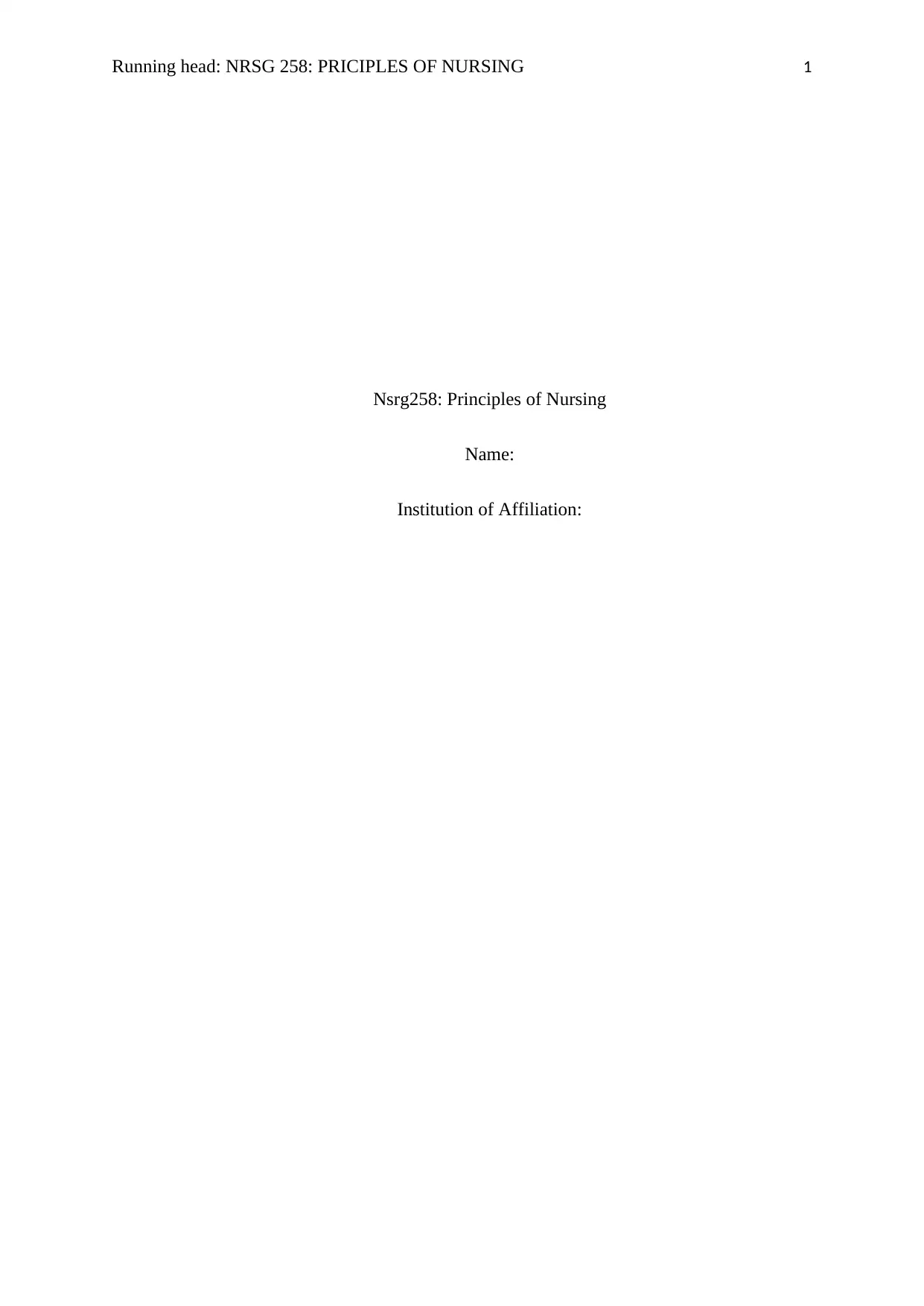
Running head: NRSG 258: PRICIPLES OF NURSING 1
Nsrg258: Principles of Nursing
Name:
Institution of Affiliation:
Nsrg258: Principles of Nursing
Name:
Institution of Affiliation:
Paraphrase This Document
Need a fresh take? Get an instant paraphrase of this document with our AI Paraphraser
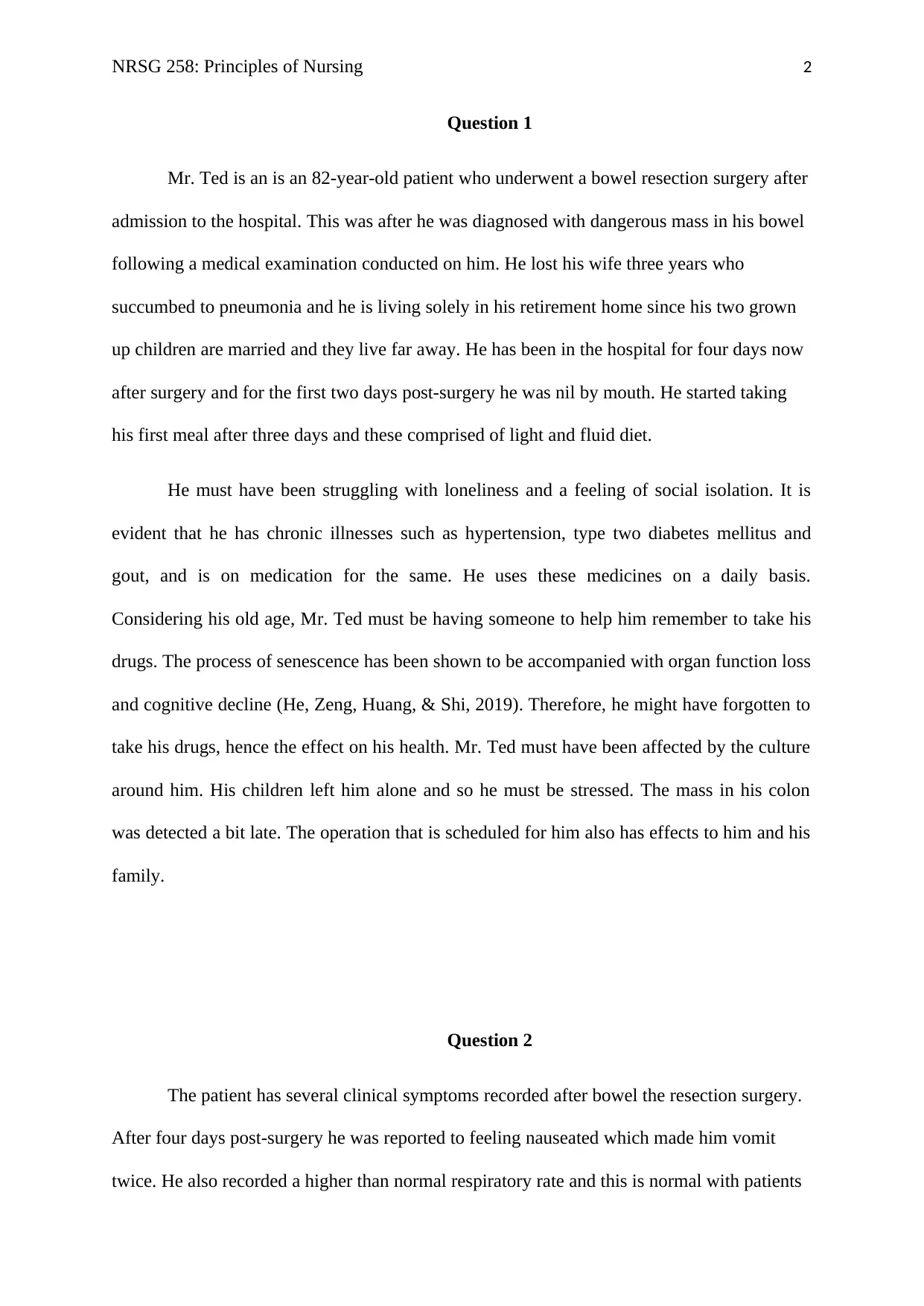
NRSG 258: Principles of Nursing 2
Question 1
Mr. Ted is an is an 82-year-old patient who underwent a bowel resection surgery after
admission to the hospital. This was after he was diagnosed with dangerous mass in his bowel
following a medical examination conducted on him. He lost his wife three years who
succumbed to pneumonia and he is living solely in his retirement home since his two grown
up children are married and they live far away. He has been in the hospital for four days now
after surgery and for the first two days post-surgery he was nil by mouth. He started taking
his first meal after three days and these comprised of light and fluid diet.
He must have been struggling with loneliness and a feeling of social isolation. It is
evident that he has chronic illnesses such as hypertension, type two diabetes mellitus and
gout, and is on medication for the same. He uses these medicines on a daily basis.
Considering his old age, Mr. Ted must be having someone to help him remember to take his
drugs. The process of senescence has been shown to be accompanied with organ function loss
and cognitive decline (He, Zeng, Huang, & Shi, 2019). Therefore, he might have forgotten to
take his drugs, hence the effect on his health. Mr. Ted must have been affected by the culture
around him. His children left him alone and so he must be stressed. The mass in his colon
was detected a bit late. The operation that is scheduled for him also has effects to him and his
family.
Question 2
The patient has several clinical symptoms recorded after bowel the resection surgery.
After four days post-surgery he was reported to feeling nauseated which made him vomit
twice. He also recorded a higher than normal respiratory rate and this is normal with patients
Question 1
Mr. Ted is an is an 82-year-old patient who underwent a bowel resection surgery after
admission to the hospital. This was after he was diagnosed with dangerous mass in his bowel
following a medical examination conducted on him. He lost his wife three years who
succumbed to pneumonia and he is living solely in his retirement home since his two grown
up children are married and they live far away. He has been in the hospital for four days now
after surgery and for the first two days post-surgery he was nil by mouth. He started taking
his first meal after three days and these comprised of light and fluid diet.
He must have been struggling with loneliness and a feeling of social isolation. It is
evident that he has chronic illnesses such as hypertension, type two diabetes mellitus and
gout, and is on medication for the same. He uses these medicines on a daily basis.
Considering his old age, Mr. Ted must be having someone to help him remember to take his
drugs. The process of senescence has been shown to be accompanied with organ function loss
and cognitive decline (He, Zeng, Huang, & Shi, 2019). Therefore, he might have forgotten to
take his drugs, hence the effect on his health. Mr. Ted must have been affected by the culture
around him. His children left him alone and so he must be stressed. The mass in his colon
was detected a bit late. The operation that is scheduled for him also has effects to him and his
family.
Question 2
The patient has several clinical symptoms recorded after bowel the resection surgery.
After four days post-surgery he was reported to feeling nauseated which made him vomit
twice. He also recorded a higher than normal respiratory rate and this is normal with patients
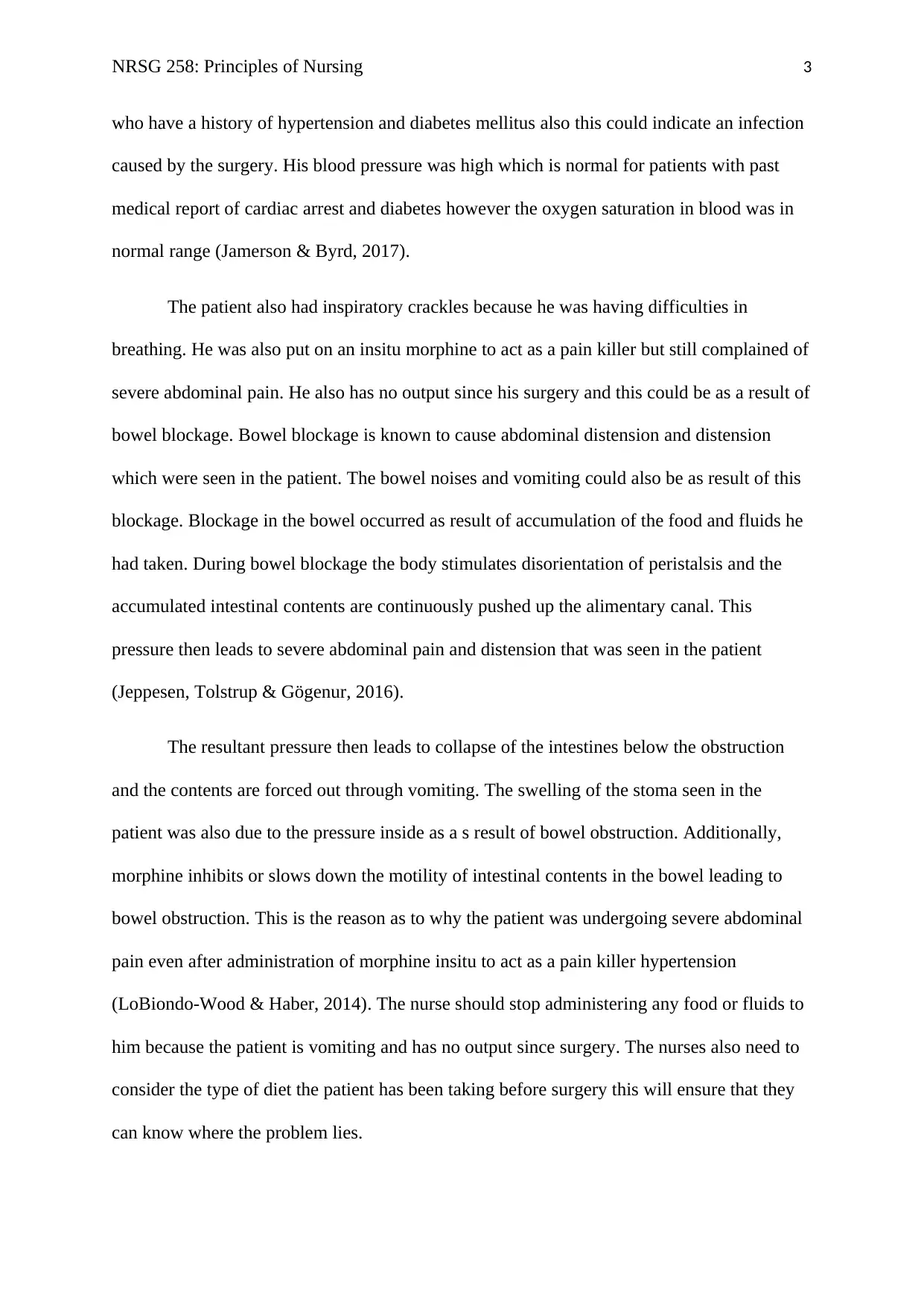
NRSG 258: Principles of Nursing 3
who have a history of hypertension and diabetes mellitus also this could indicate an infection
caused by the surgery. His blood pressure was high which is normal for patients with past
medical report of cardiac arrest and diabetes however the oxygen saturation in blood was in
normal range (Jamerson & Byrd, 2017).
The patient also had inspiratory crackles because he was having difficulties in
breathing. He was also put on an insitu morphine to act as a pain killer but still complained of
severe abdominal pain. He also has no output since his surgery and this could be as a result of
bowel blockage. Bowel blockage is known to cause abdominal distension and distension
which were seen in the patient. The bowel noises and vomiting could also be as result of this
blockage. Blockage in the bowel occurred as result of accumulation of the food and fluids he
had taken. During bowel blockage the body stimulates disorientation of peristalsis and the
accumulated intestinal contents are continuously pushed up the alimentary canal. This
pressure then leads to severe abdominal pain and distension that was seen in the patient
(Jeppesen, Tolstrup & Gögenur, 2016).
The resultant pressure then leads to collapse of the intestines below the obstruction
and the contents are forced out through vomiting. The swelling of the stoma seen in the
patient was also due to the pressure inside as a s result of bowel obstruction. Additionally,
morphine inhibits or slows down the motility of intestinal contents in the bowel leading to
bowel obstruction. This is the reason as to why the patient was undergoing severe abdominal
pain even after administration of morphine insitu to act as a pain killer hypertension
(LoBiondo-Wood & Haber, 2014). The nurse should stop administering any food or fluids to
him because the patient is vomiting and has no output since surgery. The nurses also need to
consider the type of diet the patient has been taking before surgery this will ensure that they
can know where the problem lies.
who have a history of hypertension and diabetes mellitus also this could indicate an infection
caused by the surgery. His blood pressure was high which is normal for patients with past
medical report of cardiac arrest and diabetes however the oxygen saturation in blood was in
normal range (Jamerson & Byrd, 2017).
The patient also had inspiratory crackles because he was having difficulties in
breathing. He was also put on an insitu morphine to act as a pain killer but still complained of
severe abdominal pain. He also has no output since his surgery and this could be as a result of
bowel blockage. Bowel blockage is known to cause abdominal distension and distension
which were seen in the patient. The bowel noises and vomiting could also be as result of this
blockage. Blockage in the bowel occurred as result of accumulation of the food and fluids he
had taken. During bowel blockage the body stimulates disorientation of peristalsis and the
accumulated intestinal contents are continuously pushed up the alimentary canal. This
pressure then leads to severe abdominal pain and distension that was seen in the patient
(Jeppesen, Tolstrup & Gögenur, 2016).
The resultant pressure then leads to collapse of the intestines below the obstruction
and the contents are forced out through vomiting. The swelling of the stoma seen in the
patient was also due to the pressure inside as a s result of bowel obstruction. Additionally,
morphine inhibits or slows down the motility of intestinal contents in the bowel leading to
bowel obstruction. This is the reason as to why the patient was undergoing severe abdominal
pain even after administration of morphine insitu to act as a pain killer hypertension
(LoBiondo-Wood & Haber, 2014). The nurse should stop administering any food or fluids to
him because the patient is vomiting and has no output since surgery. The nurses also need to
consider the type of diet the patient has been taking before surgery this will ensure that they
can know where the problem lies.
⊘ This is a preview!⊘
Do you want full access?
Subscribe today to unlock all pages.

Trusted by 1+ million students worldwide
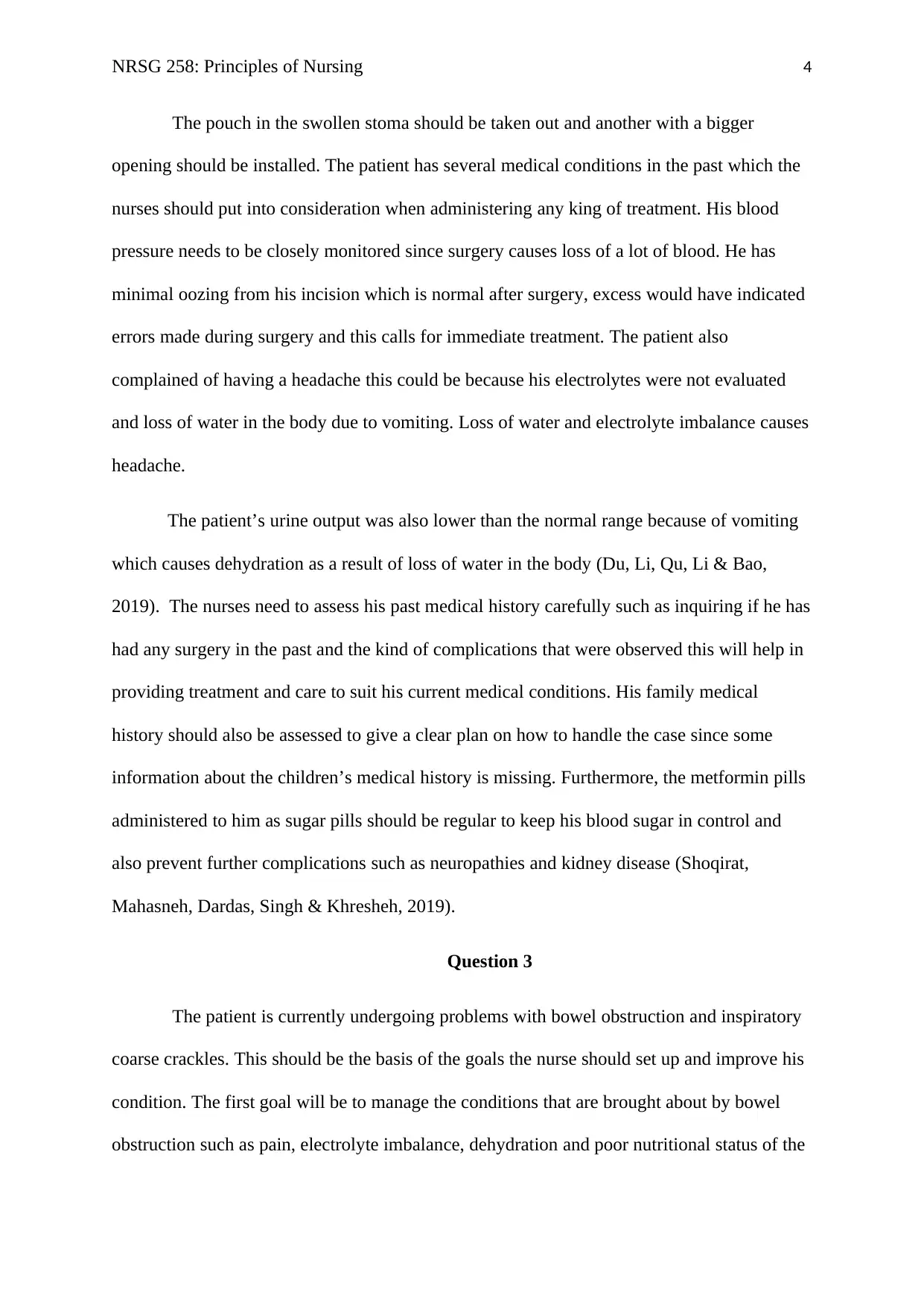
NRSG 258: Principles of Nursing 4
The pouch in the swollen stoma should be taken out and another with a bigger
opening should be installed. The patient has several medical conditions in the past which the
nurses should put into consideration when administering any king of treatment. His blood
pressure needs to be closely monitored since surgery causes loss of a lot of blood. He has
minimal oozing from his incision which is normal after surgery, excess would have indicated
errors made during surgery and this calls for immediate treatment. The patient also
complained of having a headache this could be because his electrolytes were not evaluated
and loss of water in the body due to vomiting. Loss of water and electrolyte imbalance causes
headache.
The patient’s urine output was also lower than the normal range because of vomiting
which causes dehydration as a result of loss of water in the body (Du, Li, Qu, Li & Bao,
2019). The nurses need to assess his past medical history carefully such as inquiring if he has
had any surgery in the past and the kind of complications that were observed this will help in
providing treatment and care to suit his current medical conditions. His family medical
history should also be assessed to give a clear plan on how to handle the case since some
information about the children’s medical history is missing. Furthermore, the metformin pills
administered to him as sugar pills should be regular to keep his blood sugar in control and
also prevent further complications such as neuropathies and kidney disease (Shoqirat,
Mahasneh, Dardas, Singh & Khresheh, 2019).
Question 3
The patient is currently undergoing problems with bowel obstruction and inspiratory
coarse crackles. This should be the basis of the goals the nurse should set up and improve his
condition. The first goal will be to manage the conditions that are brought about by bowel
obstruction such as pain, electrolyte imbalance, dehydration and poor nutritional status of the
The pouch in the swollen stoma should be taken out and another with a bigger
opening should be installed. The patient has several medical conditions in the past which the
nurses should put into consideration when administering any king of treatment. His blood
pressure needs to be closely monitored since surgery causes loss of a lot of blood. He has
minimal oozing from his incision which is normal after surgery, excess would have indicated
errors made during surgery and this calls for immediate treatment. The patient also
complained of having a headache this could be because his electrolytes were not evaluated
and loss of water in the body due to vomiting. Loss of water and electrolyte imbalance causes
headache.
The patient’s urine output was also lower than the normal range because of vomiting
which causes dehydration as a result of loss of water in the body (Du, Li, Qu, Li & Bao,
2019). The nurses need to assess his past medical history carefully such as inquiring if he has
had any surgery in the past and the kind of complications that were observed this will help in
providing treatment and care to suit his current medical conditions. His family medical
history should also be assessed to give a clear plan on how to handle the case since some
information about the children’s medical history is missing. Furthermore, the metformin pills
administered to him as sugar pills should be regular to keep his blood sugar in control and
also prevent further complications such as neuropathies and kidney disease (Shoqirat,
Mahasneh, Dardas, Singh & Khresheh, 2019).
Question 3
The patient is currently undergoing problems with bowel obstruction and inspiratory
coarse crackles. This should be the basis of the goals the nurse should set up and improve his
condition. The first goal will be to manage the conditions that are brought about by bowel
obstruction such as pain, electrolyte imbalance, dehydration and poor nutritional status of the
Paraphrase This Document
Need a fresh take? Get an instant paraphrase of this document with our AI Paraphraser
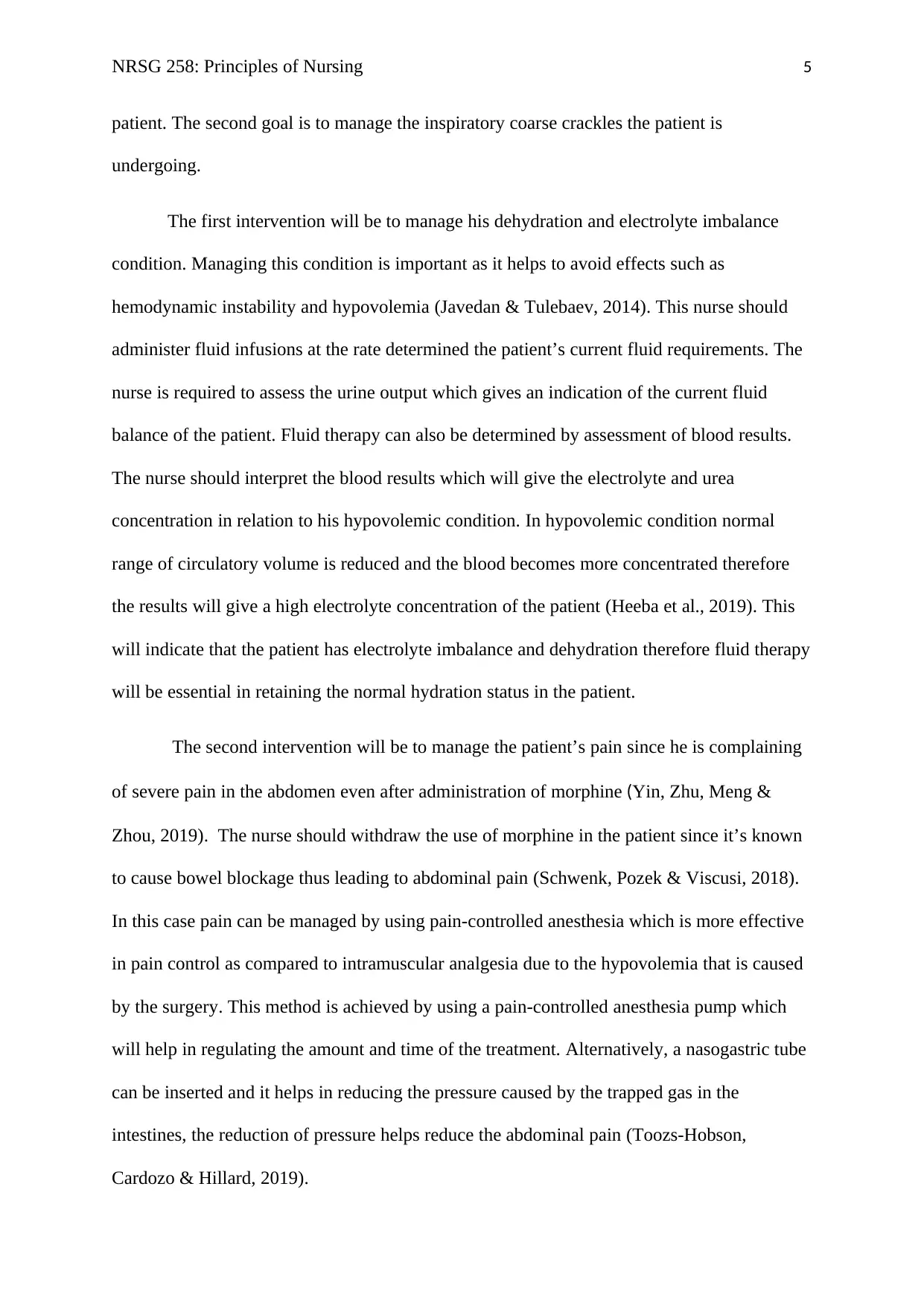
NRSG 258: Principles of Nursing 5
patient. The second goal is to manage the inspiratory coarse crackles the patient is
undergoing.
The first intervention will be to manage his dehydration and electrolyte imbalance
condition. Managing this condition is important as it helps to avoid effects such as
hemodynamic instability and hypovolemia (Javedan & Tulebaev, 2014). This nurse should
administer fluid infusions at the rate determined the patient’s current fluid requirements. The
nurse is required to assess the urine output which gives an indication of the current fluid
balance of the patient. Fluid therapy can also be determined by assessment of blood results.
The nurse should interpret the blood results which will give the electrolyte and urea
concentration in relation to his hypovolemic condition. In hypovolemic condition normal
range of circulatory volume is reduced and the blood becomes more concentrated therefore
the results will give a high electrolyte concentration of the patient (Heeba et al., 2019). This
will indicate that the patient has electrolyte imbalance and dehydration therefore fluid therapy
will be essential in retaining the normal hydration status in the patient.
The second intervention will be to manage the patient’s pain since he is complaining
of severe pain in the abdomen even after administration of morphine (Yin, Zhu, Meng &
Zhou, 2019). The nurse should withdraw the use of morphine in the patient since it’s known
to cause bowel blockage thus leading to abdominal pain (Schwenk, Pozek & Viscusi, 2018).
In this case pain can be managed by using pain-controlled anesthesia which is more effective
in pain control as compared to intramuscular analgesia due to the hypovolemia that is caused
by the surgery. This method is achieved by using a pain-controlled anesthesia pump which
will help in regulating the amount and time of the treatment. Alternatively, a nasogastric tube
can be inserted and it helps in reducing the pressure caused by the trapped gas in the
intestines, the reduction of pressure helps reduce the abdominal pain (Toozs-Hobson,
Cardozo & Hillard, 2019).
patient. The second goal is to manage the inspiratory coarse crackles the patient is
undergoing.
The first intervention will be to manage his dehydration and electrolyte imbalance
condition. Managing this condition is important as it helps to avoid effects such as
hemodynamic instability and hypovolemia (Javedan & Tulebaev, 2014). This nurse should
administer fluid infusions at the rate determined the patient’s current fluid requirements. The
nurse is required to assess the urine output which gives an indication of the current fluid
balance of the patient. Fluid therapy can also be determined by assessment of blood results.
The nurse should interpret the blood results which will give the electrolyte and urea
concentration in relation to his hypovolemic condition. In hypovolemic condition normal
range of circulatory volume is reduced and the blood becomes more concentrated therefore
the results will give a high electrolyte concentration of the patient (Heeba et al., 2019). This
will indicate that the patient has electrolyte imbalance and dehydration therefore fluid therapy
will be essential in retaining the normal hydration status in the patient.
The second intervention will be to manage the patient’s pain since he is complaining
of severe pain in the abdomen even after administration of morphine (Yin, Zhu, Meng &
Zhou, 2019). The nurse should withdraw the use of morphine in the patient since it’s known
to cause bowel blockage thus leading to abdominal pain (Schwenk, Pozek & Viscusi, 2018).
In this case pain can be managed by using pain-controlled anesthesia which is more effective
in pain control as compared to intramuscular analgesia due to the hypovolemia that is caused
by the surgery. This method is achieved by using a pain-controlled anesthesia pump which
will help in regulating the amount and time of the treatment. Alternatively, a nasogastric tube
can be inserted and it helps in reducing the pressure caused by the trapped gas in the
intestines, the reduction of pressure helps reduce the abdominal pain (Toozs-Hobson,
Cardozo & Hillard, 2019).
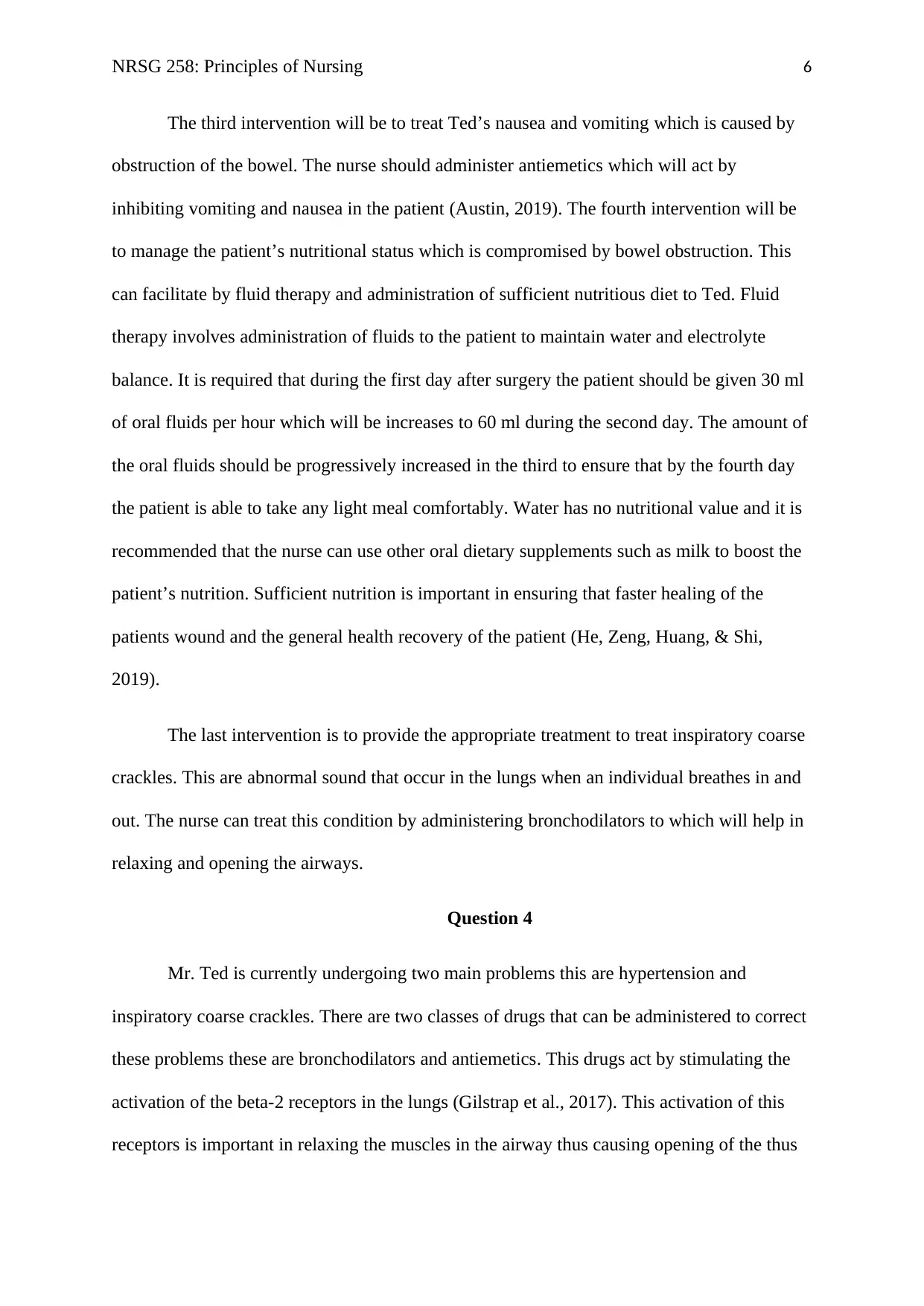
NRSG 258: Principles of Nursing 6
The third intervention will be to treat Ted’s nausea and vomiting which is caused by
obstruction of the bowel. The nurse should administer antiemetics which will act by
inhibiting vomiting and nausea in the patient (Austin, 2019). The fourth intervention will be
to manage the patient’s nutritional status which is compromised by bowel obstruction. This
can facilitate by fluid therapy and administration of sufficient nutritious diet to Ted. Fluid
therapy involves administration of fluids to the patient to maintain water and electrolyte
balance. It is required that during the first day after surgery the patient should be given 30 ml
of oral fluids per hour which will be increases to 60 ml during the second day. The amount of
the oral fluids should be progressively increased in the third to ensure that by the fourth day
the patient is able to take any light meal comfortably. Water has no nutritional value and it is
recommended that the nurse can use other oral dietary supplements such as milk to boost the
patient’s nutrition. Sufficient nutrition is important in ensuring that faster healing of the
patients wound and the general health recovery of the patient (He, Zeng, Huang, & Shi,
2019).
The last intervention is to provide the appropriate treatment to treat inspiratory coarse
crackles. This are abnormal sound that occur in the lungs when an individual breathes in and
out. The nurse can treat this condition by administering bronchodilators to which will help in
relaxing and opening the airways.
Question 4
Mr. Ted is currently undergoing two main problems this are hypertension and
inspiratory coarse crackles. There are two classes of drugs that can be administered to correct
these problems these are bronchodilators and antiemetics. This drugs act by stimulating the
activation of the beta-2 receptors in the lungs (Gilstrap et al., 2017). This activation of this
receptors is important in relaxing the muscles in the airway thus causing opening of the thus
The third intervention will be to treat Ted’s nausea and vomiting which is caused by
obstruction of the bowel. The nurse should administer antiemetics which will act by
inhibiting vomiting and nausea in the patient (Austin, 2019). The fourth intervention will be
to manage the patient’s nutritional status which is compromised by bowel obstruction. This
can facilitate by fluid therapy and administration of sufficient nutritious diet to Ted. Fluid
therapy involves administration of fluids to the patient to maintain water and electrolyte
balance. It is required that during the first day after surgery the patient should be given 30 ml
of oral fluids per hour which will be increases to 60 ml during the second day. The amount of
the oral fluids should be progressively increased in the third to ensure that by the fourth day
the patient is able to take any light meal comfortably. Water has no nutritional value and it is
recommended that the nurse can use other oral dietary supplements such as milk to boost the
patient’s nutrition. Sufficient nutrition is important in ensuring that faster healing of the
patients wound and the general health recovery of the patient (He, Zeng, Huang, & Shi,
2019).
The last intervention is to provide the appropriate treatment to treat inspiratory coarse
crackles. This are abnormal sound that occur in the lungs when an individual breathes in and
out. The nurse can treat this condition by administering bronchodilators to which will help in
relaxing and opening the airways.
Question 4
Mr. Ted is currently undergoing two main problems this are hypertension and
inspiratory coarse crackles. There are two classes of drugs that can be administered to correct
these problems these are bronchodilators and antiemetics. This drugs act by stimulating the
activation of the beta-2 receptors in the lungs (Gilstrap et al., 2017). This activation of this
receptors is important in relaxing the muscles in the airway thus causing opening of the thus
⊘ This is a preview!⊘
Do you want full access?
Subscribe today to unlock all pages.

Trusted by 1+ million students worldwide
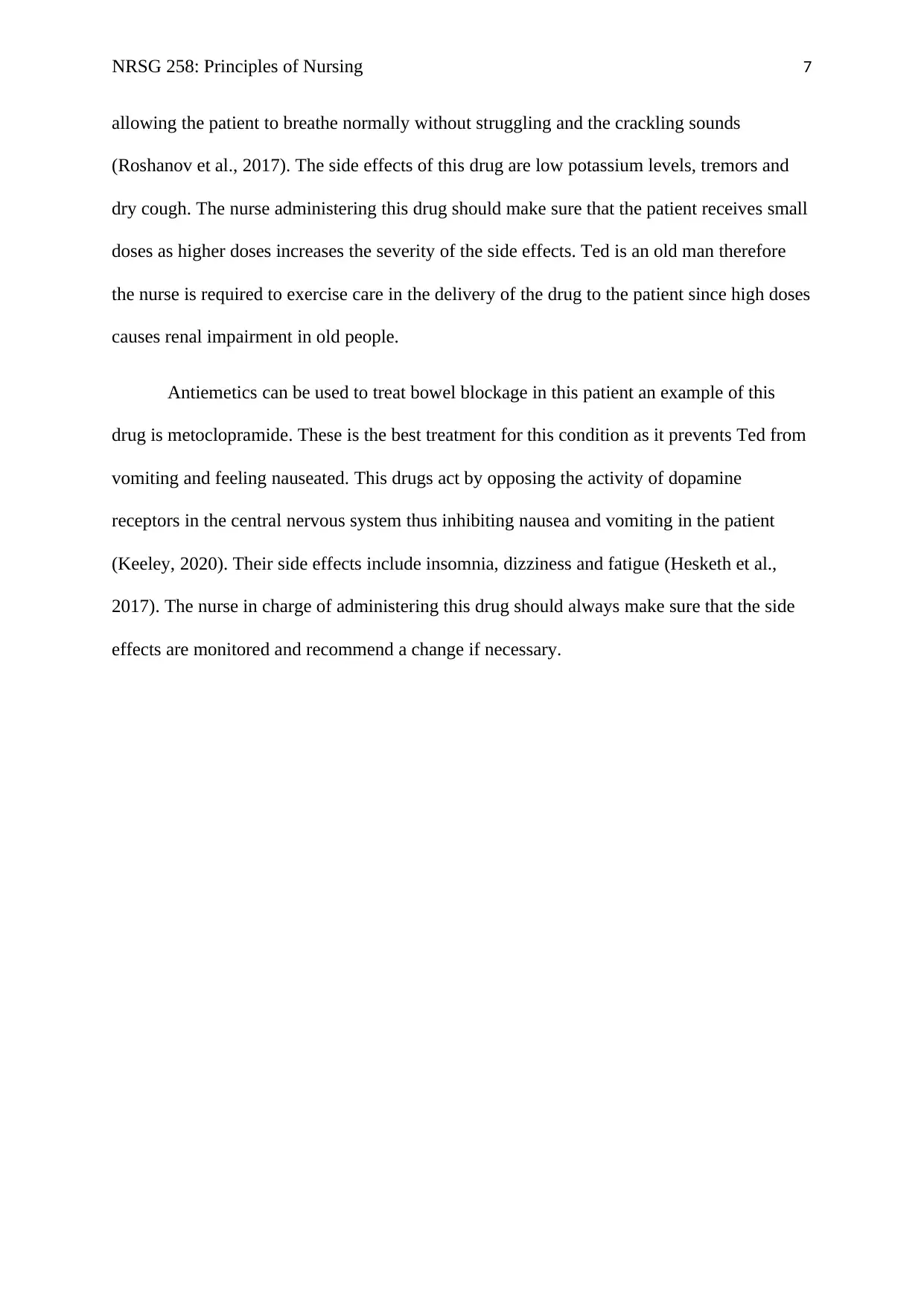
NRSG 258: Principles of Nursing 7
allowing the patient to breathe normally without struggling and the crackling sounds
(Roshanov et al., 2017). The side effects of this drug are low potassium levels, tremors and
dry cough. The nurse administering this drug should make sure that the patient receives small
doses as higher doses increases the severity of the side effects. Ted is an old man therefore
the nurse is required to exercise care in the delivery of the drug to the patient since high doses
causes renal impairment in old people.
Antiemetics can be used to treat bowel blockage in this patient an example of this
drug is metoclopramide. These is the best treatment for this condition as it prevents Ted from
vomiting and feeling nauseated. This drugs act by opposing the activity of dopamine
receptors in the central nervous system thus inhibiting nausea and vomiting in the patient
(Keeley, 2020). Their side effects include insomnia, dizziness and fatigue (Hesketh et al.,
2017). The nurse in charge of administering this drug should always make sure that the side
effects are monitored and recommend a change if necessary.
allowing the patient to breathe normally without struggling and the crackling sounds
(Roshanov et al., 2017). The side effects of this drug are low potassium levels, tremors and
dry cough. The nurse administering this drug should make sure that the patient receives small
doses as higher doses increases the severity of the side effects. Ted is an old man therefore
the nurse is required to exercise care in the delivery of the drug to the patient since high doses
causes renal impairment in old people.
Antiemetics can be used to treat bowel blockage in this patient an example of this
drug is metoclopramide. These is the best treatment for this condition as it prevents Ted from
vomiting and feeling nauseated. This drugs act by opposing the activity of dopamine
receptors in the central nervous system thus inhibiting nausea and vomiting in the patient
(Keeley, 2020). Their side effects include insomnia, dizziness and fatigue (Hesketh et al.,
2017). The nurse in charge of administering this drug should always make sure that the side
effects are monitored and recommend a change if necessary.
Paraphrase This Document
Need a fresh take? Get an instant paraphrase of this document with our AI Paraphraser
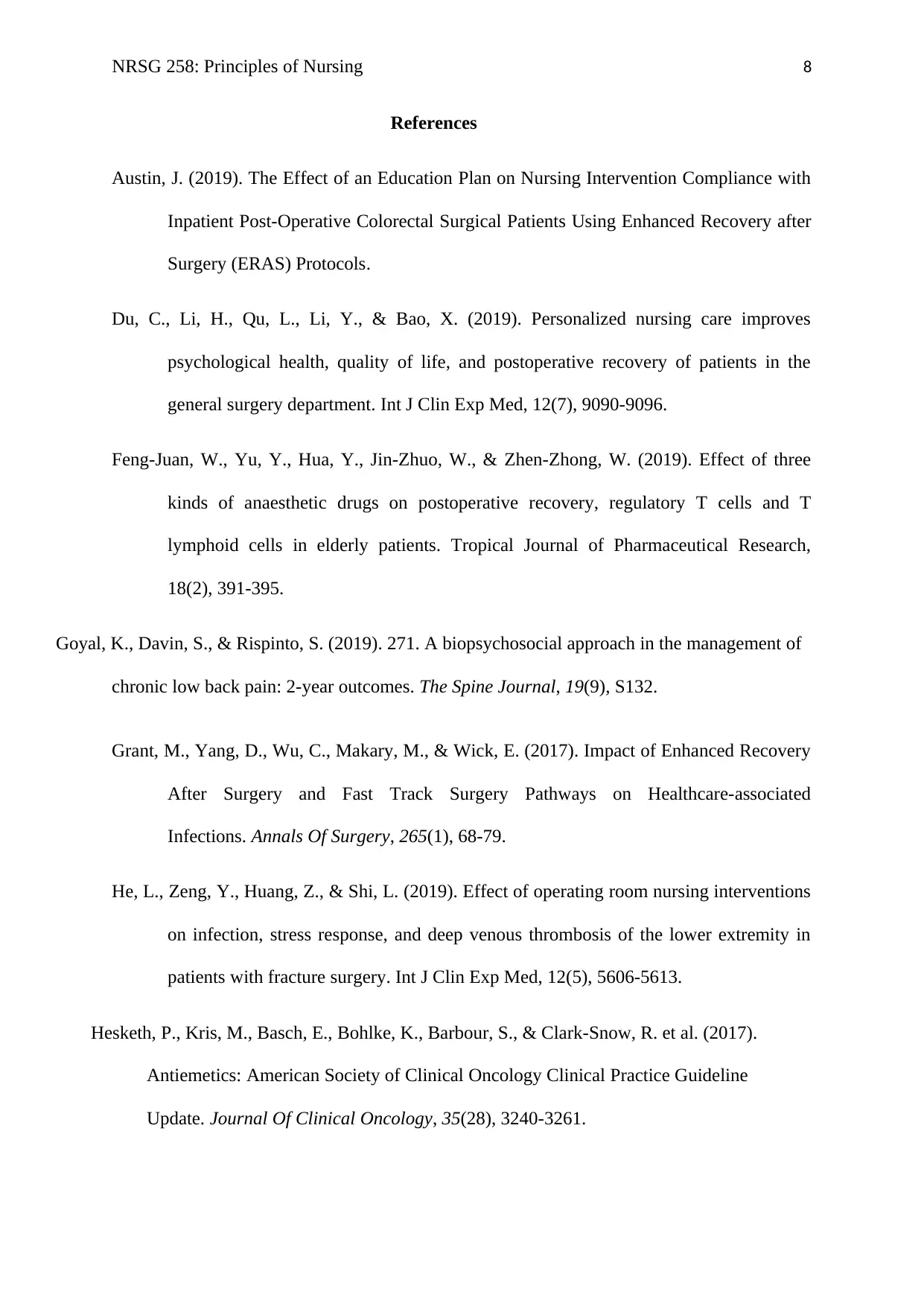
NRSG 258: Principles of Nursing 8
References
Austin, J. (2019). The Effect of an Education Plan on Nursing Intervention Compliance with
Inpatient Post-Operative Colorectal Surgical Patients Using Enhanced Recovery after
Surgery (ERAS) Protocols.
Du, C., Li, H., Qu, L., Li, Y., & Bao, X. (2019). Personalized nursing care improves
psychological health, quality of life, and postoperative recovery of patients in the
general surgery department. Int J Clin Exp Med, 12(7), 9090-9096.
Feng-Juan, W., Yu, Y., Hua, Y., Jin-Zhuo, W., & Zhen-Zhong, W. (2019). Effect of three
kinds of anaesthetic drugs on postoperative recovery, regulatory T cells and T
lymphoid cells in elderly patients. Tropical Journal of Pharmaceutical Research,
18(2), 391-395.
Goyal, K., Davin, S., & Rispinto, S. (2019). 271. A biopsychosocial approach in the management of
chronic low back pain: 2-year outcomes. The Spine Journal, 19(9), S132.
Grant, M., Yang, D., Wu, C., Makary, M., & Wick, E. (2017). Impact of Enhanced Recovery
After Surgery and Fast Track Surgery Pathways on Healthcare-associated
Infections. Annals Of Surgery, 265(1), 68-79.
He, L., Zeng, Y., Huang, Z., & Shi, L. (2019). Effect of operating room nursing interventions
on infection, stress response, and deep venous thrombosis of the lower extremity in
patients with fracture surgery. Int J Clin Exp Med, 12(5), 5606-5613.
Hesketh, P., Kris, M., Basch, E., Bohlke, K., Barbour, S., & Clark-Snow, R. et al. (2017).
Antiemetics: American Society of Clinical Oncology Clinical Practice Guideline
Update. Journal Of Clinical Oncology, 35(28), 3240-3261.
References
Austin, J. (2019). The Effect of an Education Plan on Nursing Intervention Compliance with
Inpatient Post-Operative Colorectal Surgical Patients Using Enhanced Recovery after
Surgery (ERAS) Protocols.
Du, C., Li, H., Qu, L., Li, Y., & Bao, X. (2019). Personalized nursing care improves
psychological health, quality of life, and postoperative recovery of patients in the
general surgery department. Int J Clin Exp Med, 12(7), 9090-9096.
Feng-Juan, W., Yu, Y., Hua, Y., Jin-Zhuo, W., & Zhen-Zhong, W. (2019). Effect of three
kinds of anaesthetic drugs on postoperative recovery, regulatory T cells and T
lymphoid cells in elderly patients. Tropical Journal of Pharmaceutical Research,
18(2), 391-395.
Goyal, K., Davin, S., & Rispinto, S. (2019). 271. A biopsychosocial approach in the management of
chronic low back pain: 2-year outcomes. The Spine Journal, 19(9), S132.
Grant, M., Yang, D., Wu, C., Makary, M., & Wick, E. (2017). Impact of Enhanced Recovery
After Surgery and Fast Track Surgery Pathways on Healthcare-associated
Infections. Annals Of Surgery, 265(1), 68-79.
He, L., Zeng, Y., Huang, Z., & Shi, L. (2019). Effect of operating room nursing interventions
on infection, stress response, and deep venous thrombosis of the lower extremity in
patients with fracture surgery. Int J Clin Exp Med, 12(5), 5606-5613.
Hesketh, P., Kris, M., Basch, E., Bohlke, K., Barbour, S., & Clark-Snow, R. et al. (2017).
Antiemetics: American Society of Clinical Oncology Clinical Practice Guideline
Update. Journal Of Clinical Oncology, 35(28), 3240-3261.
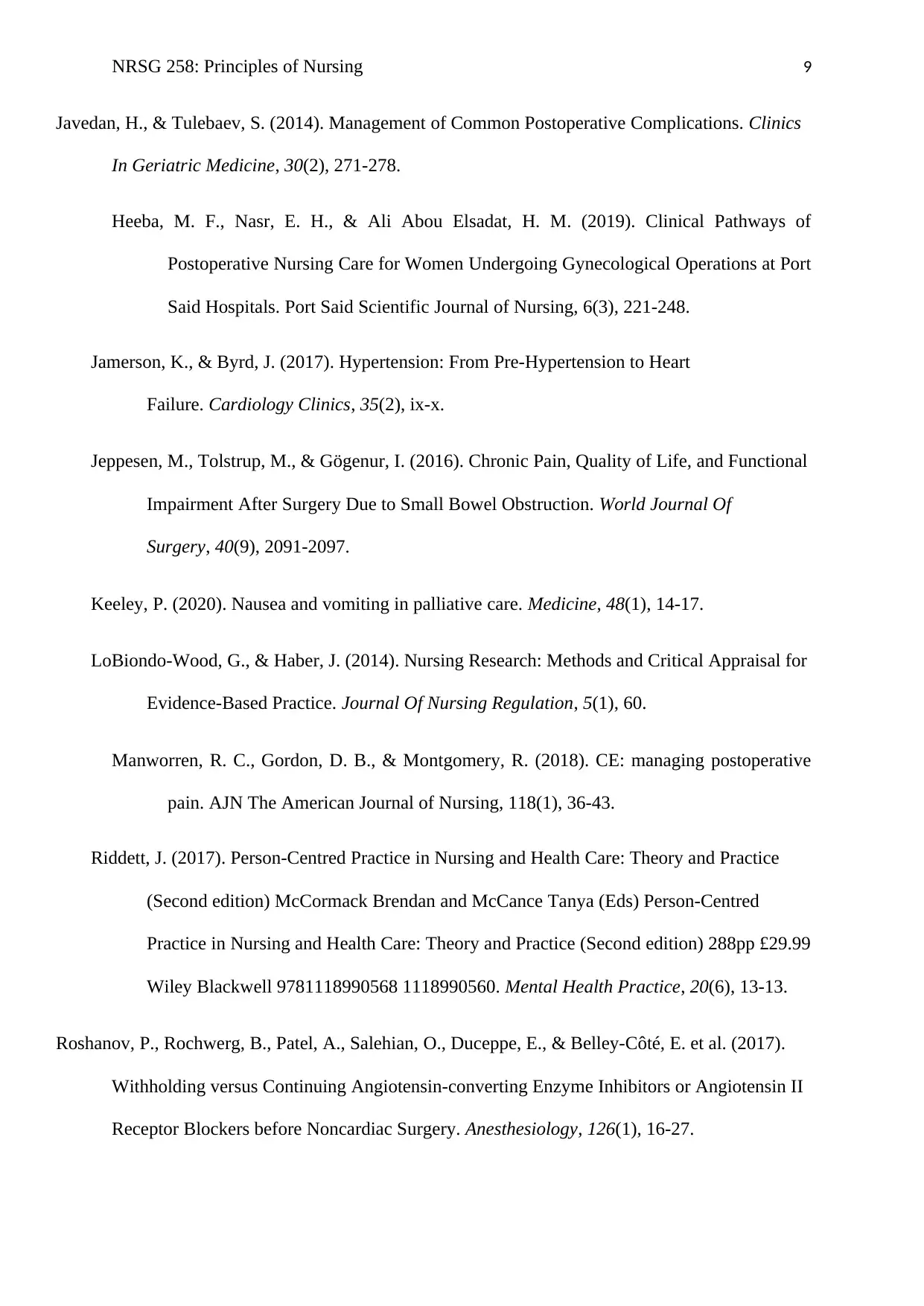
NRSG 258: Principles of Nursing 9
Javedan, H., & Tulebaev, S. (2014). Management of Common Postoperative Complications. Clinics
In Geriatric Medicine, 30(2), 271-278.
Heeba, M. F., Nasr, E. H., & Ali Abou Elsadat, H. M. (2019). Clinical Pathways of
Postoperative Nursing Care for Women Undergoing Gynecological Operations at Port
Said Hospitals. Port Said Scientific Journal of Nursing, 6(3), 221-248.
Jamerson, K., & Byrd, J. (2017). Hypertension: From Pre-Hypertension to Heart
Failure. Cardiology Clinics, 35(2), ix-x.
Jeppesen, M., Tolstrup, M., & Gögenur, I. (2016). Chronic Pain, Quality of Life, and Functional
Impairment After Surgery Due to Small Bowel Obstruction. World Journal Of
Surgery, 40(9), 2091-2097.
Keeley, P. (2020). Nausea and vomiting in palliative care. Medicine, 48(1), 14-17.
LoBiondo-Wood, G., & Haber, J. (2014). Nursing Research: Methods and Critical Appraisal for
Evidence-Based Practice. Journal Of Nursing Regulation, 5(1), 60.
Manworren, R. C., Gordon, D. B., & Montgomery, R. (2018). CE: managing postoperative
pain. AJN The American Journal of Nursing, 118(1), 36-43.
Riddett, J. (2017). Person-Centred Practice in Nursing and Health Care: Theory and Practice
(Second edition) McCormack Brendan and McCance Tanya (Eds) Person-Centred
Practice in Nursing and Health Care: Theory and Practice (Second edition) 288pp £29.99
Wiley Blackwell 9781118990568 1118990560. Mental Health Practice, 20(6), 13-13.
Roshanov, P., Rochwerg, B., Patel, A., Salehian, O., Duceppe, E., & Belley-Côté, E. et al. (2017).
Withholding versus Continuing Angiotensin-converting Enzyme Inhibitors or Angiotensin II
Receptor Blockers before Noncardiac Surgery. Anesthesiology, 126(1), 16-27.
Javedan, H., & Tulebaev, S. (2014). Management of Common Postoperative Complications. Clinics
In Geriatric Medicine, 30(2), 271-278.
Heeba, M. F., Nasr, E. H., & Ali Abou Elsadat, H. M. (2019). Clinical Pathways of
Postoperative Nursing Care for Women Undergoing Gynecological Operations at Port
Said Hospitals. Port Said Scientific Journal of Nursing, 6(3), 221-248.
Jamerson, K., & Byrd, J. (2017). Hypertension: From Pre-Hypertension to Heart
Failure. Cardiology Clinics, 35(2), ix-x.
Jeppesen, M., Tolstrup, M., & Gögenur, I. (2016). Chronic Pain, Quality of Life, and Functional
Impairment After Surgery Due to Small Bowel Obstruction. World Journal Of
Surgery, 40(9), 2091-2097.
Keeley, P. (2020). Nausea and vomiting in palliative care. Medicine, 48(1), 14-17.
LoBiondo-Wood, G., & Haber, J. (2014). Nursing Research: Methods and Critical Appraisal for
Evidence-Based Practice. Journal Of Nursing Regulation, 5(1), 60.
Manworren, R. C., Gordon, D. B., & Montgomery, R. (2018). CE: managing postoperative
pain. AJN The American Journal of Nursing, 118(1), 36-43.
Riddett, J. (2017). Person-Centred Practice in Nursing and Health Care: Theory and Practice
(Second edition) McCormack Brendan and McCance Tanya (Eds) Person-Centred
Practice in Nursing and Health Care: Theory and Practice (Second edition) 288pp £29.99
Wiley Blackwell 9781118990568 1118990560. Mental Health Practice, 20(6), 13-13.
Roshanov, P., Rochwerg, B., Patel, A., Salehian, O., Duceppe, E., & Belley-Côté, E. et al. (2017).
Withholding versus Continuing Angiotensin-converting Enzyme Inhibitors or Angiotensin II
Receptor Blockers before Noncardiac Surgery. Anesthesiology, 126(1), 16-27.
⊘ This is a preview!⊘
Do you want full access?
Subscribe today to unlock all pages.

Trusted by 1+ million students worldwide
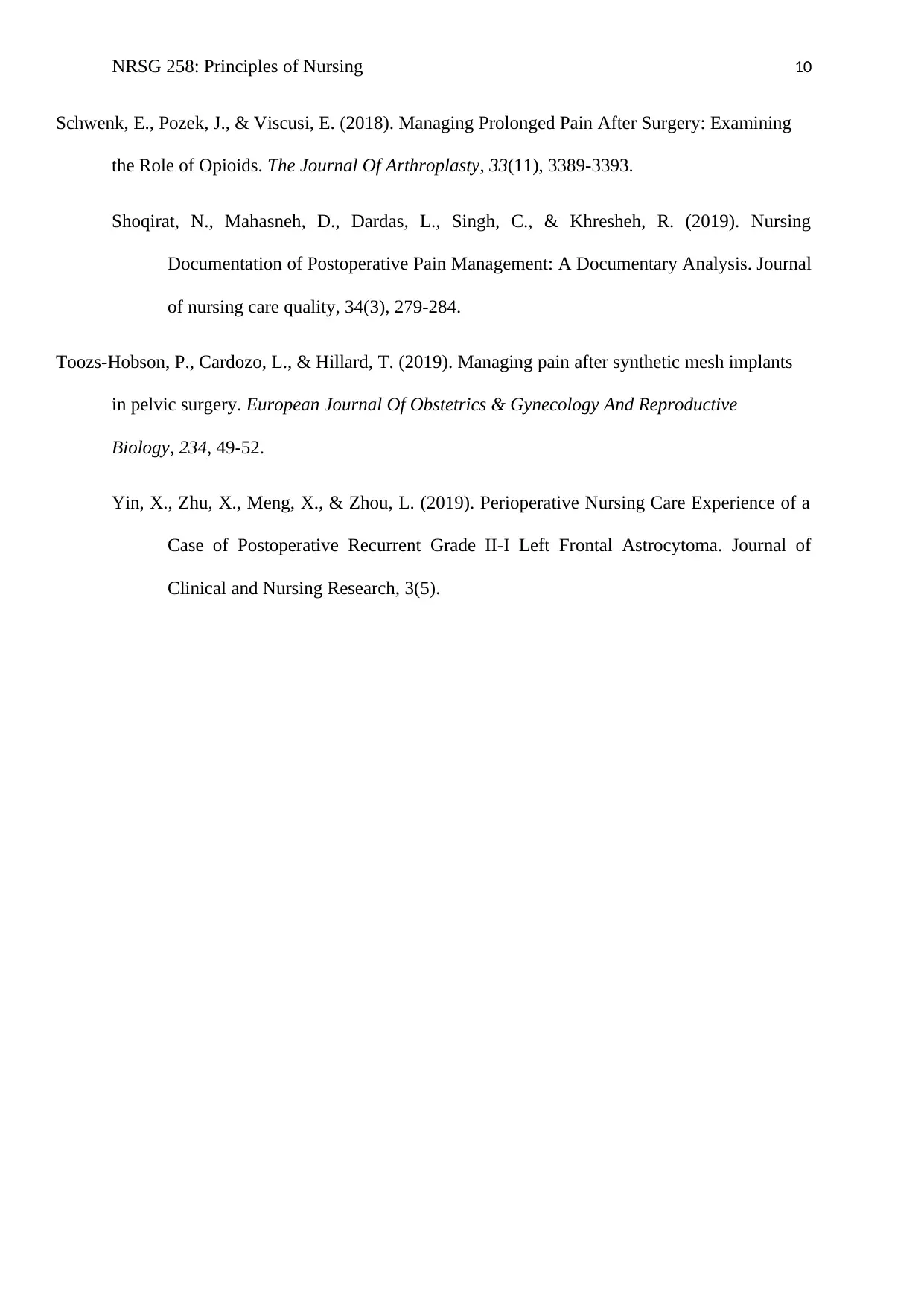
NRSG 258: Principles of Nursing 10
Schwenk, E., Pozek, J., & Viscusi, E. (2018). Managing Prolonged Pain After Surgery: Examining
the Role of Opioids. The Journal Of Arthroplasty, 33(11), 3389-3393.
Shoqirat, N., Mahasneh, D., Dardas, L., Singh, C., & Khresheh, R. (2019). Nursing
Documentation of Postoperative Pain Management: A Documentary Analysis. Journal
of nursing care quality, 34(3), 279-284.
Toozs-Hobson, P., Cardozo, L., & Hillard, T. (2019). Managing pain after synthetic mesh implants
in pelvic surgery. European Journal Of Obstetrics & Gynecology And Reproductive
Biology, 234, 49-52.
Yin, X., Zhu, X., Meng, X., & Zhou, L. (2019). Perioperative Nursing Care Experience of a
Case of Postoperative Recurrent Grade II-I Left Frontal Astrocytoma. Journal of
Clinical and Nursing Research, 3(5).
Schwenk, E., Pozek, J., & Viscusi, E. (2018). Managing Prolonged Pain After Surgery: Examining
the Role of Opioids. The Journal Of Arthroplasty, 33(11), 3389-3393.
Shoqirat, N., Mahasneh, D., Dardas, L., Singh, C., & Khresheh, R. (2019). Nursing
Documentation of Postoperative Pain Management: A Documentary Analysis. Journal
of nursing care quality, 34(3), 279-284.
Toozs-Hobson, P., Cardozo, L., & Hillard, T. (2019). Managing pain after synthetic mesh implants
in pelvic surgery. European Journal Of Obstetrics & Gynecology And Reproductive
Biology, 234, 49-52.
Yin, X., Zhu, X., Meng, X., & Zhou, L. (2019). Perioperative Nursing Care Experience of a
Case of Postoperative Recurrent Grade II-I Left Frontal Astrocytoma. Journal of
Clinical and Nursing Research, 3(5).
Paraphrase This Document
Need a fresh take? Get an instant paraphrase of this document with our AI Paraphraser

NRSG 258: Principles of Nursing 11
1 out of 11
Related Documents
Your All-in-One AI-Powered Toolkit for Academic Success.
+13062052269
info@desklib.com
Available 24*7 on WhatsApp / Email
![[object Object]](/_next/static/media/star-bottom.7253800d.svg)
Unlock your academic potential
Copyright © 2020–2025 A2Z Services. All Rights Reserved. Developed and managed by ZUCOL.





